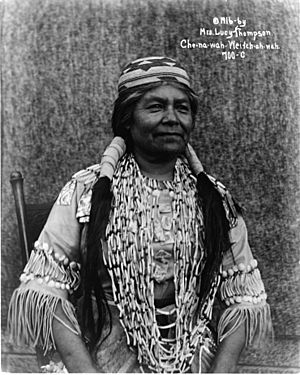Lucy Thompson facts for kids
Quick facts for kids
Lucy Thompson
|
|
|---|---|

Lucy Thompson
|
|
| Born |
Che-Na-Wah Weitch-Ah-Wah
1856 Pek-won Village, California
|
| Died | February 23, 1932 |
| Nationality | Yurok |
| Known for | Authorship |
|
Notable work
|
To the American Indian: Reminiscences of a Yurok Woman |
Lucy Thompson (Yurok: Che-na-wah Weitch-ah-wah; 1856-1932) was an important Native American author. She is famous for her book, To the American Indian: Reminiscences of a Yurok Woman.
She wrote this book in 1916 to save the stories of her people. Her goal was to help others understand the Yurok people better. Decades later, in 1992, her book won the American Book Award. Lucy Thompson was born in a village called Pecwan, located along the Klamath River in California. She wanted to share stories that others were not telling. She also cared deeply about the Klamath River salmon.
Her Life Story
Lucy Thompson was born on October 29, 1856. Her Yurok name was Che-na-wah Weitch-ah-wah. She grew up in Pec-Wan Village, which is in Northern California. She was a member of the Yurok Tribe.
Her father trained her to be a Talth. A Talth is a spiritual leader for the tribe. In 1875, she married Jim Thompson. He was a white man who worked with timber. Jim was also an important member of the local Masonic Lodge.
Lucy and Jim lived along the Klamath River for many years. In 1910, they moved to Eureka, California. Lucy Thompson passed away in Eureka on February 23, 1932. This was just over a year after her husband died.
Awards and Recognition
Lucy Thompson's book received a special honor. She won the American Book Award in 1992. This award recognized her important work.
Her Main Book
Lucy Thompson's most important work is her book. It is called To the American Indian: Reminiscences of a Yurok Woman. This book was first published in 1916.
It is a nonfiction book about her own life. It also shares stories about other Yurok tribe members. The book gives readers a look into Yurok life. It describes their experiences in California in the late 1800s and early 1900s.

